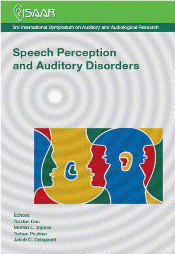Auditory and cognitive contributions to hearing-impaired listeners’ spatial speech recognition performance
Abstract
This study investigated the auditory and cognitive processes affecting speech recognition in spatially complex, multi-talker situations. Twenty- three elderly hearing-impaired (HI) listeners were tested on a number of competing-speech tasks, a measure of monaural spectral ripple discrimination, a measure of binaural temporal fine structure (TFS) sensitivity, and two cognitive measures indexing working memory and attention. All auditory test stimuli were spectrally shaped to restore (partial) audibility for each listener on each listening task. Eight younger normal- hearing (NH) listeners served as a control group. Data analyses revealed that the chosen auditory and cognitive measures were unable to predict speech recognition when the target and maskers were separated along the front-back dimension. When the competing talkers were separated along the left-right dimension, however, speech recognition was correlated with the measures of attention and binaural TFS sensitivity as well as with low- frequency hearing thresholds. Altogether, these results support the notion that both bottom-up and top-down deficits are responsible for the impaired functioning of elderly HI listeners in cocktail party-like situations.
References
Blauert, J. (1997). Spatial Hearing: The Psychophysics of Human Sound Localization (The MIT Press, Cambridge, MA).
Behrens, T., Neher, T., and Johannesson, R.B. (2008). “Evaluation of speech corpus for assessment of spatial release from masking” in Proceedings of ISAAR 2007: Auditory Signal Processing in Hearing-Impaired Listeners. 1st International Symposium on Auditory and Audiological Research. Elsinore, Denmark. Edited by T. Dau, J.M. Buchholz, J. Harte, and T.U. Christiansen. ISBN: 87-990013-1- 4. (The Danavox Jubilee Foundation, Copenhagen), pp. 449-457.
Daneman, M., and Carpenter, P.A. (1980). “Individual differences in integrating information between and within sentences” J. Exp. Psychol. Learn. Mem. Cogn. 9, 561-584.
Lunner, T., Neher, T., Hopkins, K., and Moore, B.C.J. (2010). “Sensitivity to low- frequency temporal fine structure is correlated with aided spatial release from masking” presented at the 2010 International Hearing Aid Research Conference (IHCON), Lake Tahoe, California, Aug. 11-15.
Marrone, N.L., Mason, C.R., and Kidd, G.Jr. (2008). “The effects of hearing loss and age on the benefit of spatial separation between multiple talkers in reverberant rooms” J. Acoust. Soc. Am. 124, 3064-3075.
Neher, T., Behrens, T., Carlile, S., Jin, C., Kragelund, L., Petersen, A.S., and van Schaik, A. (2009). “Benefit from spatial separation of bilateral hearing-aid users: Effects of hearing loss, age, and cognition” Int. J. Audiol. 48, 758-774.
Neher, T., Laugesen, S., Jensen, N.S., and Kragelund, L. (2011). “Can basic auditory and cognitive measures predict hearing-impaired listeners’ localization and spatial speech recognition abilities?” J. Acoust. Soc. Am. 130, 1542-1558.
Robertson, I.H., Ward, T., Ridgeway, V., and Nimmo-Smith, I. (1996). “The structure of normal human attention: The Test of Everyday Attention” J. Int. Neuropsychol. Soc. 2, 525-534.
Ross, B., Tremblay, K.L., and Picton, T.W. (2007). “Physiological detection of interaural phase differences” J. Acoust. Soc. Am. 121, 1017-1027.
Salthouse, T. (1982). Adult Cognition (Springer Verlag, New York).
Strelcyk, O., and Dau, T. (2009). “Relations between frequency selectivity, temporal fine-structure processing, and speech reception in impaired hearing” J. Acoust. Soc. Am. 125, 3328-3345.
Supin, A.Y., Popov, V.V., Milekhina, O.N., and Tarakanov, M.B. (1994). “Frequency resolving power measured by rippled noise” Hear Res. 78, 31-40. Wagener, K., Josvassen, J.L., and Ardenkjær, R. (2003). “Design, evaluation and optimization of a Danish sentence test in noise” Int. J. Audiol. 42, 10-17.
Additional Files
Published
How to Cite
Issue
Section
License
Authors who publish with this journal agree to the following terms:
a. Authors retain copyright* and grant the journal right of first publication with the work simultaneously licensed under a Creative Commons Attribution License that allows others to share the work with an acknowledgement of the work's authorship and initial publication in this journal.
b. Authors are able to enter into separate, additional contractual arrangements for the non-exclusive distribution of the journal's published version of the work (e.g., post it to an institutional repository or publish it in a book), with an acknowledgement of its initial publication in this journal.
c. Authors are permitted and encouraged to post their work online (e.g., in institutional repositories or on their website) prior to and during the submission process, as it can lead to productive exchanges, as well as earlier and greater citation of published work (See The Effect of Open Access).
*From the 2017 issue onward. The Danavox Jubilee Foundation owns the copyright of all articles published in the 1969-2015 issues. However, authors are still allowed to share the work with an acknowledgement of the work's authorship and initial publication in this journal.


